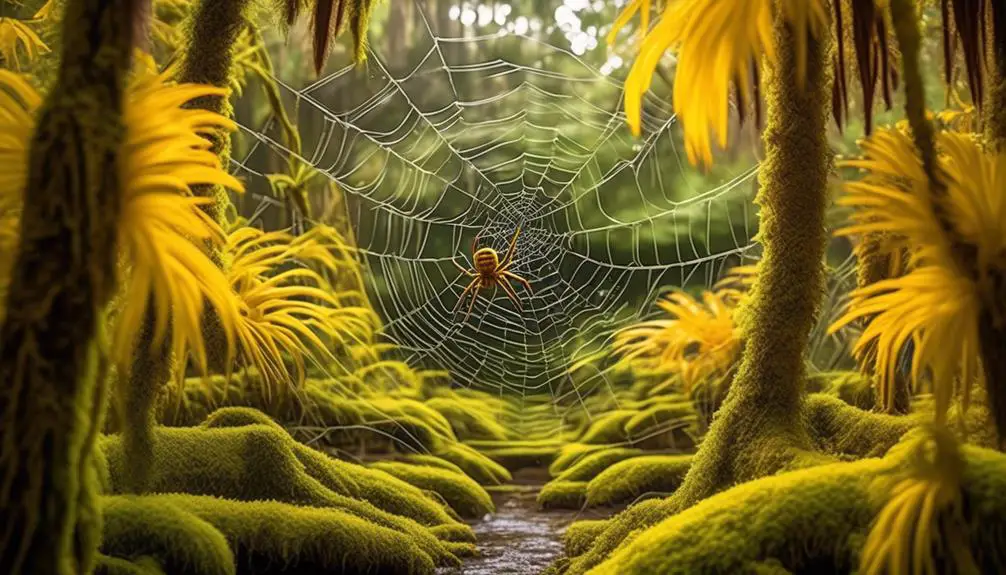Are you ready to uncover the hidden world of common spiders in Florida? Just like the intricate threads of a spider’s web, these fascinating creatures are woven into the very fabric of the Sunshine State.
From the bustling cities to the serene countryside, spiders of all shapes and sizes can be found lurking in the shadows, waiting for their next prey. But fear not, for not all spiders in Florida are as menacing as they may seem.
So, prepare to embark on a journey through the diverse and captivating realm of arachnids, where a world of discovery awaits you.
Dangerous Spiders in Florida
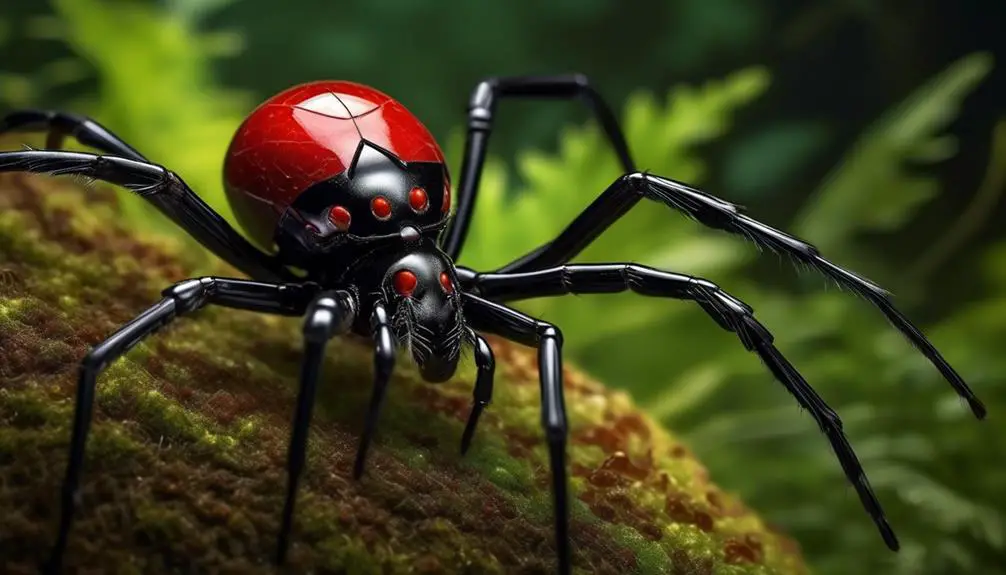
In Florida, there are several dangerous spiders that residents should be aware of. One of the most notorious is the Black Widow Spider (Latrodectus mactans). This spider is easily identifiable by its shiny black body and red hourglass-shaped marking on the underside of the abdomen. The female Black Widow is the most venomous, capable of inflicting a painful bite.
Another dangerous spider to watch out for is the Recluse Spider (Loxosceles). The most common species found in Florida is the Brown Recluse. These spiders have a violin-shaped marking on their cephalothorax. While their bites are rare, they can cause necrotic wounds that may require medical attention.
Additionally, there are various species of Widow spiders in Florida, including the Southern black widow, Northern black widow, brown widow, and red widow. These spiders possess potent venom that can cause severe symptoms in humans.
It’s important to exercise caution when encountering these spiders and seek medical attention if bitten.
Spiders That Bite in Florida
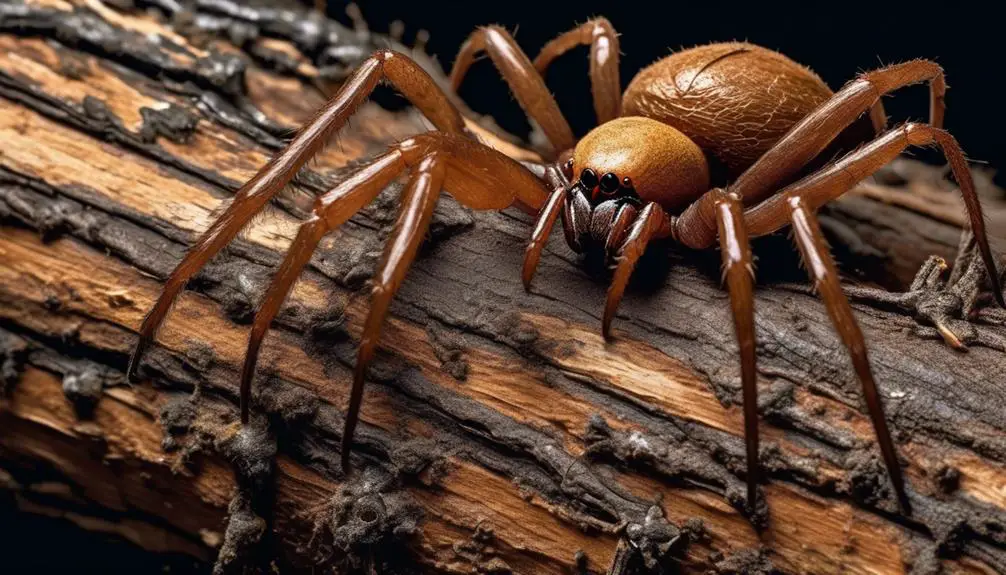
After discussing the dangerous spiders in Florida, it’s important to now focus on the spiders that are known to bite in the state. While it’s true that all spiders have the ability to bite, not all spider bites are harmful to humans. However, there are certain venomous spider species in Florida that can cause harm if they bite.
The most well-known venomous spiders in Florida are the widow species, including the Southern black widow, Northern black widow, brown widow, and red widow. These spiders belong to the genus Latrodectus and possess potent venom that can lead to severe symptoms if bitten. Another venomous spider species found in Florida is the brown recluse spider (Loxosceles), which can also cause harmful effects if it bites.
If you’re bitten by a venomous spider in Florida, it’s crucial to seek immediate medical attention. Symptoms can appear quickly and vary depending on the individual’s reaction to the venom. It’s important to note that not all venomous spider bites have severe effects on humans, but it’s always better to err on the side of caution and seek medical help.
Most Common Spiders in Florida
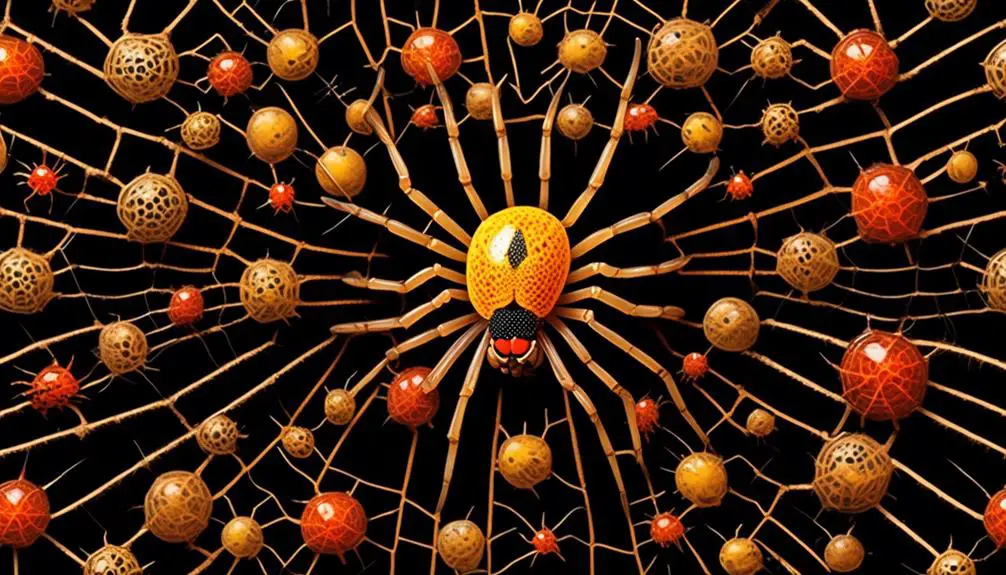
The most common spiders found in Florida include the Common House Spider, Wolf Spider, Jumping Spider, Cellar Spider, and European Garden Spider.
The Common House Spider (Parasteatoda tepidariorum) is known for its web-building abilities and can be found in homes, garages, and other structures. They’re small in size and usually brown or gray in color.
The Wolf Spider (Lycosidae) is a large and robust spider that’s commonly found in leafy or grassy areas, as well as inside houses. They’re known for their hunting behavior and don’t build webs.
The Jumping Spider (Salticidae) is known for its ability to jump long distances and its excellent eyesight. They’re often found in gardens, grasslands, and agricultural areas.
The Cellar Spider (Pholcidae) is commonly found in dark and damp places such as basements and cellars. They’re known for their long, delicate legs and their ability to catch prey in their webs.
The European Garden Spider (Araneus diadematus) is large and brightly colored, with distinctive markings on its abdomen. They’re commonly found in gardens, forests, and wooded areas.
These spiders play important roles in maintaining ecological balance and should be appreciated for their contributions to the ecosystem.
Spiders With Specific Characteristics
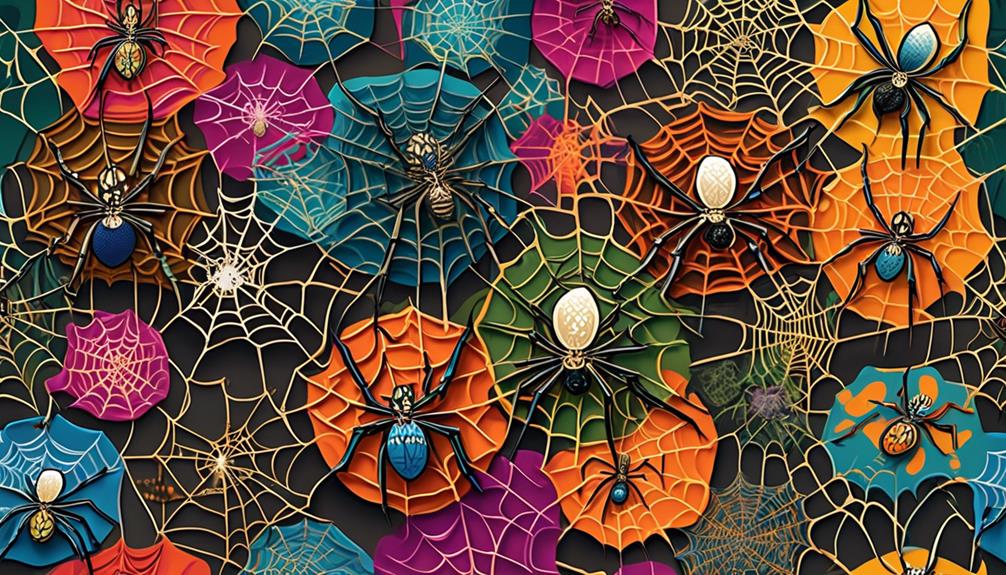
Spiders with specific characteristics exhibit distinct physical attributes, habitats, and behaviors that differentiate them from other spider species in Florida.
One such spider is the Spiny-backed Orb Weaver Spider (Gasteracantha). These spiders can be found in citrus groves, shrubbery, woodland edges, houses, and outbuildings. They’re easily recognizable by their abdomen marked with white spots, and their back and spines can be red, orange, or yellow. While not deadly to humans, they can bite if provoked, causing discomfort. Their diet consists of small fly species, beetles, and moths.
Another spider with specific characteristics is the Bold Jumping Spider (Phidippus audax). They can be found in grassland, woodlands, agricultural land, and backyards. These spiders have a white line crossing the upper part of their abdomen, with two bright white spots to the rear. They aren’t deadly to humans but may bite in self-defense. Their diet mainly consists of small insects and non-insect arthropods.
Lastly, the Banana Spider (Nephila clavipes) is another spider with distinctive characteristics. They can be found in wooded areas, gardens, and forests. The females are large with yellow and black bodies, while the males are smaller and brown. Although not deadly, they can bite if provoked, causing mild pain and swelling. Their diet includes insects such as flies, bees, and grasshoppers.
These spiders with specific characteristics have adapted to their unique habitats and display behaviors that help them thrive in their environments.
Spiders With Specific Habitats
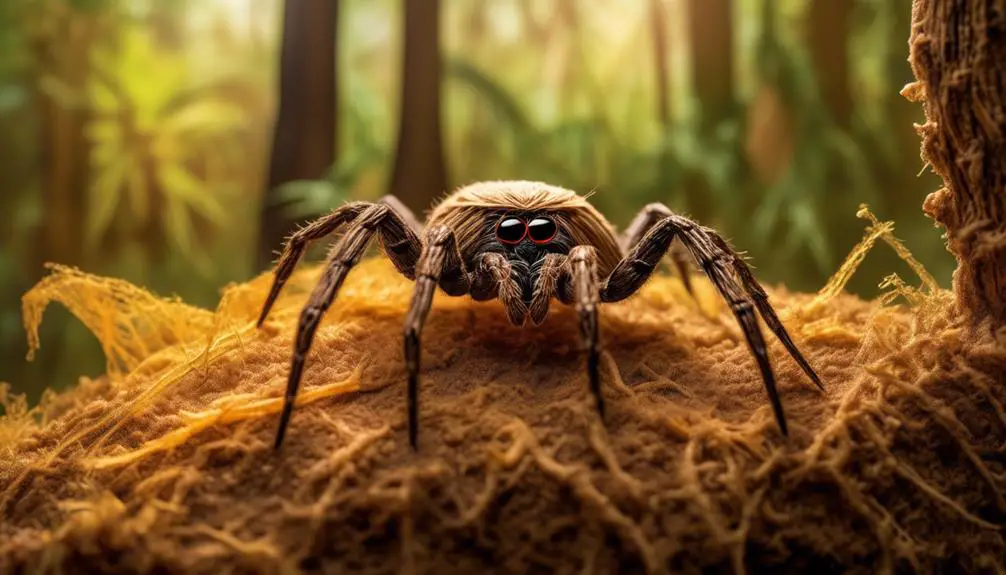
Having explored the characteristics of specific spiders in Florida, let’s now turn our attention to their distinct habitats. Spiders in Florida have adapted to various environments, each with its own unique features. To better understand their habitats, take a look at the table below:
| Spider | Habitat |
|---|---|
| Black Widow Spider (Latrodectus mactans) | Dark areas such as woodpiles or crevices, garages, basements, and cluttered areas |
| Recluse Spiders (Loxosceles) | Sheds, garages, undisturbed and dark areas of homes |
| Spiny-backed Orb Weaver Spider (Gasteracantha) | Citrus groves, shrubbery, woodland edges, houses, and outbuildings |
| Bold Jumping Spiders (Phidippus audax) | Grassland, woodlands, agricultural land, and backyards |
| Banana Spider (Nephila clavipes) | Wooded areas, gardens, and forests |
| Six-spotted fishing spider (Dolomedes triton) | Wetland including ponds, lakeshores, and slow-moving streams |
| Wolf Spider (Lycosidae) | Mostly living in leafy/grassy areas or inside houses |
These spiders have adapted to their specific habitats in order to survive and thrive. The Black Widow Spider prefers dark and cluttered areas, while the Recluse Spiders seek out undisturbed and dark spaces in homes. The Spiny-backed Orb Weaver Spider can be found in citrus groves, shrubbery, and woodland edges, while the Bold Jumping Spiders prefer grasslands, woodlands, agricultural land, and backyards. The Banana Spider can be spotted in wooded areas, gardens, and forests, while the Six-spotted fishing spider thrives in wetland environments such as ponds, lakeshores, and slow-moving streams. Lastly, the Wolf Spider can be found in leafy/grassy areas or even inside houses.
Understanding the habitats of these spiders is crucial for effective pest management and maintaining a balanced ecosystem.
Black Widow Spider
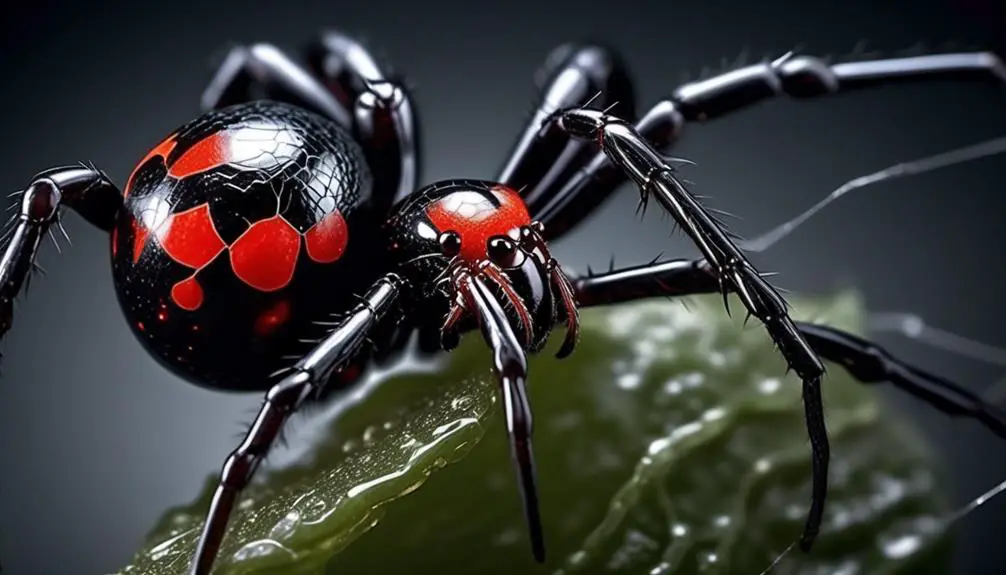
The Black Widow Spider, known for its venomous bite, is a species of spider found in various dark and cluttered areas of Florida, such as woodpiles, crevices, garages, basements, and cluttered areas. This spider belongs to the Latrodectus genus and is scientifically known as Latrodectus mactans.
It’s easily recognizable by its shiny black color and the red hourglass-shaped marking on the underside of its abdomen. The female Black Widow Spider is larger than the male, measuring about 0.5 inches in body length, while the male is only about a quarter of her size.
The venom of the Black Widow Spider contains neurotoxins that can cause severe symptoms in humans, such as muscle pain, nausea, and difficulty breathing. However, it’s important to note that bites are relatively rare, and not all bites result in envenomation.
If bitten by a Black Widow Spider, it’s recommended to seek medical attention immediately. To reduce the risk of encountering these spiders, it’s advisable to keep outdoor areas clean and clutter-free, as well as regularly inspect and clean indoor areas, especially in dark and secluded spaces.
Recluse Spiders
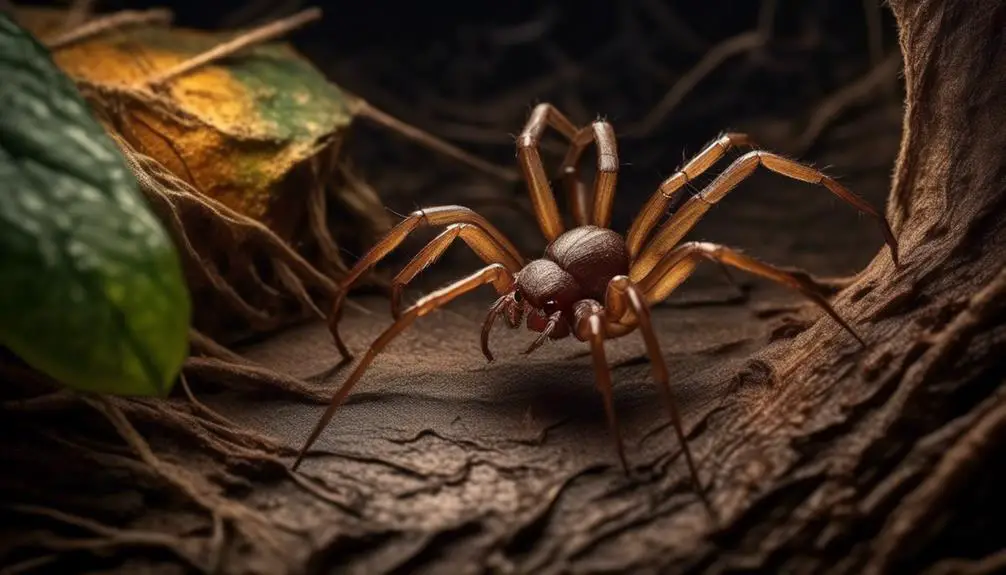
Now let’s turn our attention to Recluse Spiders in Florida.
These spiders belong to the Loxosceles genus and are known for their distinctive characteristics. They’re typically light to dark brown in color, with a violin-shaped marking on their back.
Recluse spiders are commonly found in sheds, garages, and undisturbed areas of homes. It’s important to be aware of their presence and take necessary precautions to prevent potential harm.
Identification and Characteristics
Recluse spiders in Florida, including the brown recluse (Loxosceles) species, possess distinct identification characteristics. These spiders are typically small, ranging from ¼ to ½ inch in body length. They’ve a light to medium brown coloration, with a characteristic dark brown violin-shaped marking on their cephalothorax. The legs of recluse spiders are long and slender, with no distinct bands or markings. Additionally, they’ve six eyes arranged in pairs, rather than the usual eight eyes found in many other spider species.
The abdomen of brown recluse spiders is uniformly colored, without any distinct patterns or markings. It’s important to note that while recluse spiders can deliver a bite that may cause necrotic tissue damage, they’re generally non-aggressive and only bite when threatened or disturbed.
Habitat and Behavior
Habitat and behavior patterns of recluse spiders in Florida are influenced by their preference for undisturbed and dark areas, such as sheds, garages, and certain parts of homes. Recluse spiders, belonging to the Loxosceles genus, are known for their reclusive nature and nocturnal habits. They typically build irregular webs close to the ground, hidden in corners and crevices.
These spiders are commonly found in cluttered and secluded spaces, where they can go unnoticed. Recluse spiders aren’t aggressive and will only bite if they feel threatened or trapped. Their venom contains toxins that can cause necrotic skin lesions in some individuals, although such cases are rare.
It’s important to exercise caution when handling or coming into contact with recluse spiders to avoid potential bites and adverse reactions.
Potential Harm and Prevention
To minimize the potential harm from recluse spiders, it’s crucial to take preventive measures and be aware of their presence in undisturbed and dark areas.
Recluse spiders, specifically the brown recluse (Loxosceles reclusa), can be found in sheds, garages, and other dark corners of homes. These spiders are typically non-aggressive and will only bite when provoked or threatened.
However, their venom can cause necrotic lesions in some individuals, leading to tissue damage and potential infection.
To prevent bites from recluse spiders, it’s important to regularly inspect and clean dark areas in your home, such as closets, attics, and basements. Sealing cracks and crevices in your home can also help prevent these spiders from entering.
If you suspect a recluse spider bite, seek medical attention immediately to prevent complications.
Common House Spider
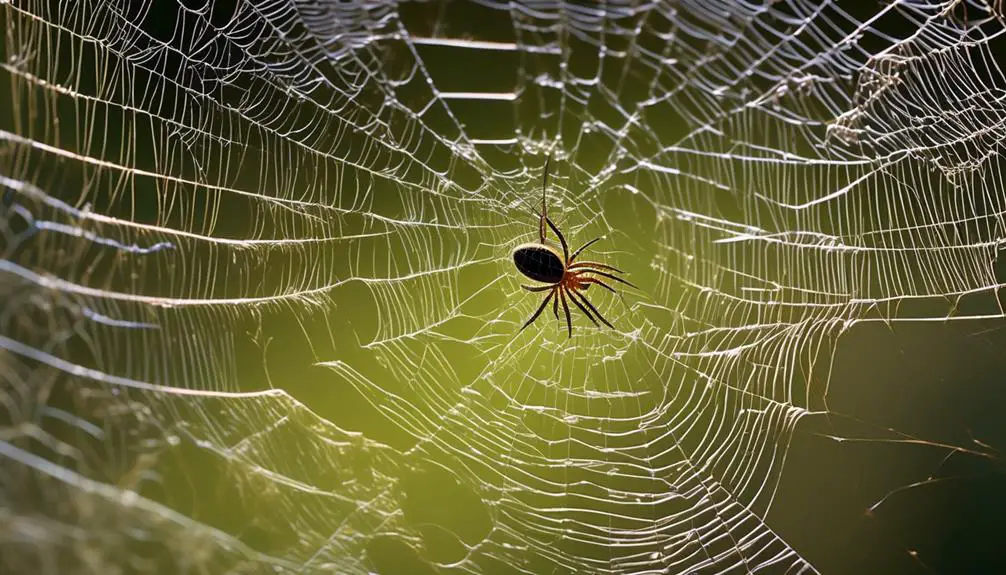
The Common House Spider, found throughout Florida, is a species that’s commonly encountered in homes and other indoor spaces. These spiders belong to the family Theridiidae and are scientifically known as Parasteatoda tepidariorum. They’re small in size, with a body length ranging from 4 to 9 millimeters. The coloration of their bodies can vary between light brown, tan, or gray, with a pattern of darker spots or stripes on their abdomen.
These spiders are skilled web-builders and construct tangled, irregular webs in corners, crevices, and other undisturbed areas of the home. Their webs are typically messy and may accumulate dust and debris over time. The purpose of these webs is to capture prey, primarily insects like flies, mosquitoes, and small beetles.
The Common House Spider isn’t considered dangerous to humans. While they possess venom that’s toxic to their prey, their venom isn’t potent enough to cause harm to humans. Bites from these spiders are rare and usually only occur when the spider feels threatened or cornered. If bitten, the resulting symptoms are generally mild and may include localized pain, redness, and swelling, which typically subside within a few hours.
To prevent encounters with Common House Spiders, it’s important to maintain a clean and clutter-free living environment. Regularly dusting and vacuuming corners and undisturbed areas can help remove spider webs and discourage their presence. Additionally, sealing cracks and gaps in windows, doors, and walls can help prevent their entry into the home.
Wolf Spider
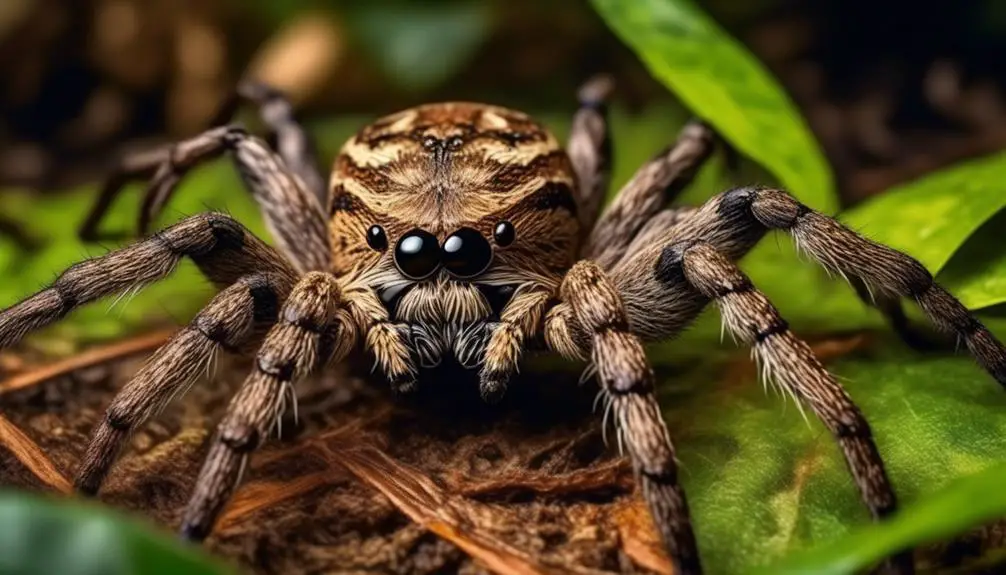
Moving on to the next spider species in Florida, let’s now focus our attention on the Wolf Spider. The Wolf Spider belongs to the family Lycosidae and is known for its hunting abilities. It is commonly found in leafy/grassy areas or even inside houses. Unlike other spiders that rely on webs to catch prey, the Wolf Spider actively hunts and pounces on its victims.
To provide a deeper understanding of the Wolf Spider, here is a table that highlights its key characteristics:
| Characteristics | Details |
|---|---|
| Size | Varies, typically 1-2 inches in length |
| Appearance | Brown or gray with dark markings on the body |
| Behavior | Solitary and nocturnal hunters |
| Venom | Mildly venomous, but not harmful to humans |
| Diet | Feeds on insects, small spiders, and even small vertebrates |
The Wolf Spider is an important predator in the ecosystem, as it helps control the population of insects and other small creatures. While their large size and swift movements may seem intimidating, they are generally not a threat to humans. If encountered, it is best to observe them from a distance and appreciate their role in maintaining equilibrium in nature.
Jumping Spider
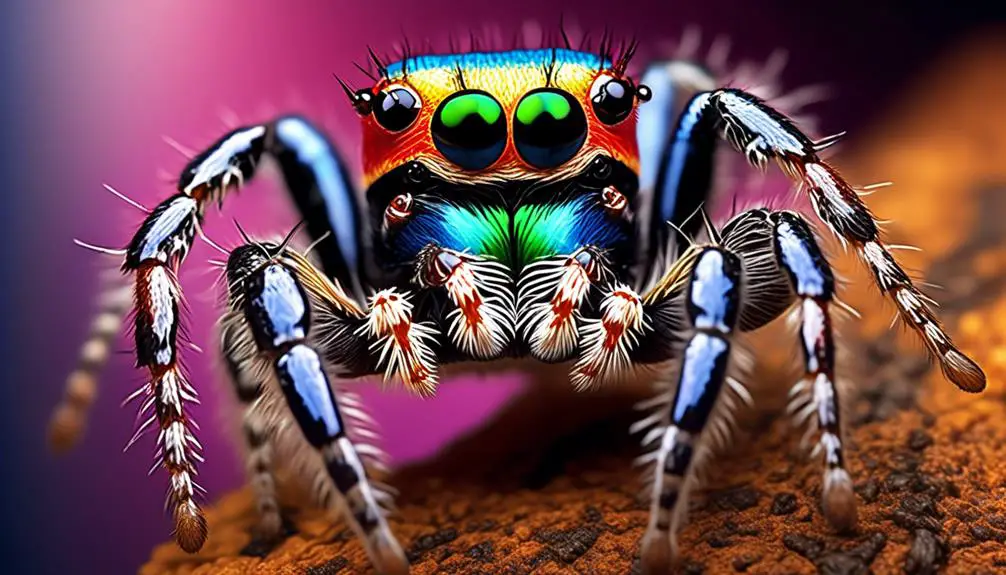
The Jumping Spider, commonly found in Florida, is known for its small size and vibrant appearance. With a body length ranging from 4 to 18 millimeters, these spiders are characterized by their compact build and large, forward-facing eyes.
They’re adept hunters, employing unique hunting techniques such as stalking and pouncing on their prey.
Size and Appearance
With its distinctive markings and agile movements, the Jumping Spider in Florida is a fascinating arachnid species to observe. This small spider, measuring only about 1/4 to 3/4 inch in length, is known for its ability to leap long distances, thanks to its muscular legs. Its body is compact and covered in short, bristly hairs, giving it a velvety appearance.
The Jumping Spider’s coloration can vary, but it often has a dark-colored cephalothorax with white or pale markings, and its abdomen may be adorned with bright colors or patterns. These spiders have excellent vision, with multiple pairs of eyes that allow them to accurately judge distances and track their prey. Overall, the Jumping Spider’s unique size, appearance, and acrobatic abilities make it a captivating species to study in the diverse ecosystem of Florida.
| Body Length | Leg Span | Coloration |
|---|---|---|
| 1/4 – 3/4 inch | Varied | Dark cephalothorax with white or pale markings; brightly colored or patterned abdomen |
*Note: The table above provides a concise summary of the Jumping Spider’s size and appearance.*
Hunting Techniques
How do Jumping Spiders in Florida utilize their unique hunting techniques to capture their prey?
Jumping spiders, known for their excellent vision and agility, employ a remarkable hunting strategy. These spiders don’t build intricate webs to ensnare their prey like other spiders; instead, they rely on their exceptional jumping ability and stealthy approach.
With their acute eyesight, they carefully stalk their prey, moving with precision and grace. When in close proximity, they pounce on their unsuspecting victim, immobilizing it with a venomous bite.
The jumping spider’s ability to leap several times their body length aids them in ambushing their prey with remarkable speed and accuracy.
Their hunting techniques showcase their adaptability and effectiveness in capturing small insects and non-insect arthropods in the diverse habitats of Florida.
Unique Characteristics
Jumping spiders in Florida possess unique characteristics that set them apart from other spider species. These spiders, scientifically known as Phidippus audax, are easily recognizable due to their distinct appearance. They have a compact body with short legs, and their most distinguishing feature is a white line that crosses the upper part of their abdomen. Additionally, they have two bright white spots towards the rear.
These spiders aren’t deadly to humans, but they may bite if provoked in self-defense. Their diet consists mainly of small insects and non-insect arthropods. Jumping spiders can be found in various habitats, including grasslands, woodlands, agricultural land, and even backyards.
Their unique characteristics make them fascinating creatures to observe in the diverse spider population of Florida.
Cellar Spider
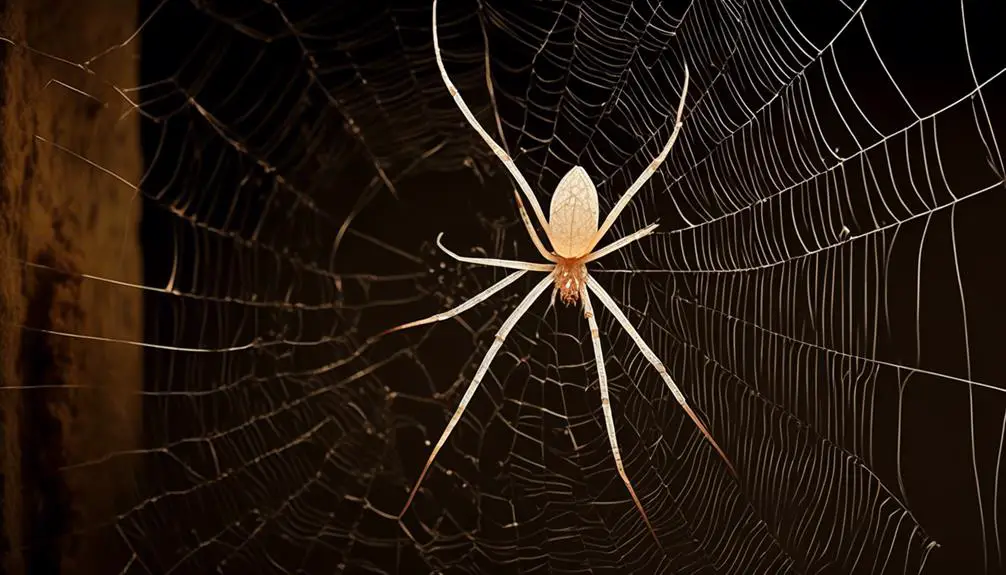
The Cellar Spider, also known as the Pholcus phalangioides, is a common spider species found in Florida. It’s scientifically classified under the family Pholcidae. These spiders are known for their delicate appearance, with thin elongated legs and a small body size. The coloration of the Cellar Spider can vary from pale yellowish-brown to light gray. One distinguishing feature of this species is its long, thin legs, which can span up to 2.5 inches in length.
Cellar Spiders are usually found in dark and damp areas such as cellars, basements, and crawl spaces, hence their common name. They construct their webs in corners and crevices, using their silk to create a tangled mass of irregular threads. These webs aren’t sticky like those of other spiders, but rather serve as a trap for their prey, which mainly consists of small insects.
Despite their somewhat intimidating appearance, Cellar Spiders aren’t harmful to humans. They aren’t known to bite unless provoked, and even if they do, their venom isn’t considered dangerous to humans. In fact, these spiders are often considered beneficial as they help control populations of other insects in and around homes.
European Garden Spider
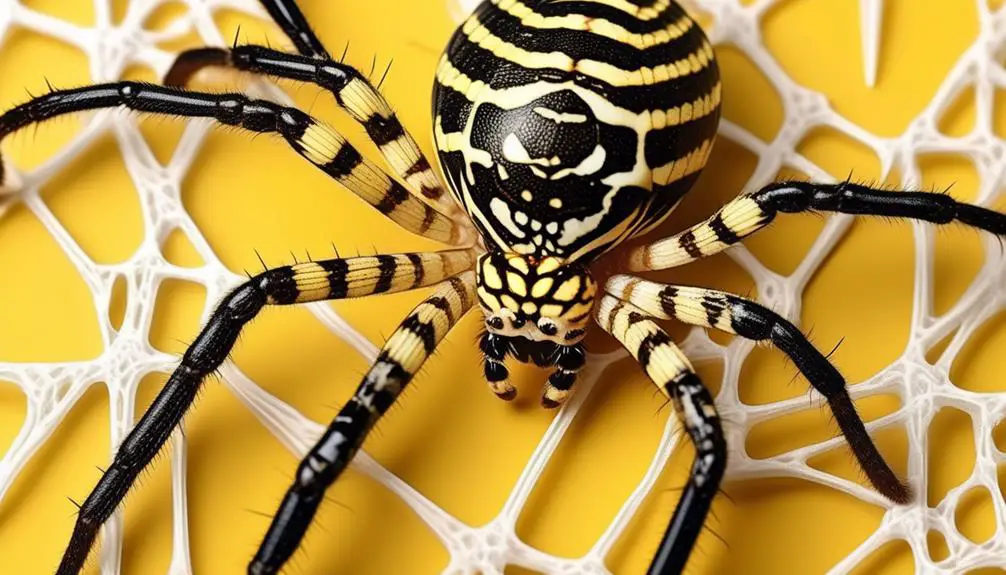
Now let’s turn our attention to the European Garden Spider, also known as the Cross Orb Weaver. This spider is easily identified by its large size and distinctive markings.
The European Garden Spider has a round abdomen with a white cross pattern on its back, surrounded by yellow or orange.
These spiders are commonly found in gardens, meadows, and woodland areas, where they spin their intricate orb-shaped webs to catch flying insects as their main source of food.
Size and Appearance
The European Garden Spider (Araneus diadematus), a common spider found in Florida, exhibits a distinct size and appearance that sets it apart from other species. These spiders have a body length ranging from 0.4 to 1 inch (10 to 25 mm) and a leg span of up to 2.5 inches (65 mm).
The females are larger than the males, with a body length of about 0.6 to 1 inch (15 to 30 mm). The European Garden Spider has a rounded abdomen, which is usually yellow or orange with black markings forming a cross shape. The cephalothorax, or head region, is typically brown with white or yellow markings. The legs are long and slender, usually brown or yellowish in color.
Habitat and Behavior
Typically found in gardens and natural spaces in Florida, the European Garden Spider (Araneus diadematus) establishes its habitat in areas abundant with foliage and vegetation. These spiders prefer to construct their intricate orb-shaped webs in open areas, such as meadows, fields, and gardens, where they can easily capture flying insects.
They’re commonly seen hanging upside down in the center of their webs, waiting patiently for prey to become ensnared. The European Garden Spider exhibits a distinctive behavior known as web rebuilding, where they dismantle and reconstruct their webs on a daily basis, usually during the evening hours. This behavior helps to ensure that the web remains strong and effective in capturing prey.
When disturbed or threatened, the European Garden Spider will vibrate its web vigorously, alerting it to the presence of potential danger.
Prey and Diet
The European Garden Spider, commonly found in gardens and natural spaces in Florida, relies on its intricate orb-shaped web to trap and capture its prey. This spider builds its web in areas where it can easily catch flying insects.
The web consists of radial lines that extend from a central hub and sticky spiral threads that ensnare unsuspecting prey. When an insect flies into the web and becomes trapped, the spider quickly rushes towards it to immobilize and secure it with silk.
The European Garden Spider primarily feeds on small flying insects such as flies, mosquitoes, and moths. Once caught, the spider injects venom into its prey to immobilize and digest it.
This efficient hunting strategy allows the European Garden Spider to obtain the nutrients it needs to survive and thrive in its habitat.

Erzsebet Frey (Eli Frey) is an ecologist and online entrepreneur with a Master of Science in Ecology from the University of Belgrade. Originally from Serbia, she has lived in Sri Lanka since 2017. Eli has worked internationally in countries like Oman, Brazil, Germany, and Sri Lanka. In 2018, she expanded into SEO and blogging, completing courses from UC Davis and Edinburgh. Eli has founded multiple websites focused on biology, ecology, environmental science, sustainable and simple living, and outdoor activities. She enjoys creating nature and simple living videos on YouTube and participates in speleology, diving, and hiking.
- WILDLIFE THEMED T-SHIRTS
Cute Hedgehog Embroidered: Love Wildlife, Protect Nature Wildlife conservation tees
$35.00

